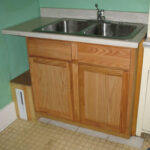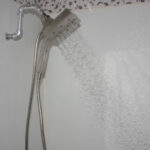So, you want to learn how to install a new bathroom sink vanity. You need to start out by picking a vanity sink and base that meets your style and most of all fits in your bathroom. The last thing you want to do is pick out a vanity base which does not fit in the room. You also must remember that building codes in your area may require a certain amount of space between the toilet and vanity. Not only space between the toilet and vanity is important but also the tub or shower can be a problem. Make sure you check your local codes on this spacing. Once you have got what you want style and spacing wise, you are ready to get the tools out.
You will need to have a couple of tools to install your new bathroom sink vanity, which will also be needed to remove the old bathroom sink vanity. A cordless drill/driver, for putting in the screws. A couple of screws about 2 inches in length to secure the vanity base to the wall. Then you will possible need shims to make sure the base is level front to back and side to side. You will need a level, pipe tape, crescent wrench, small pipe wrench. If your supply lines have a rubber gasket in the ends of it, you will not need the pipe tape. Depending on what your sink is made of, you will need plumbers putty for under the sink faucet and to seal the new drain to the drain hole on the new sink., follow installation directions for your style of sink.
You will want to make sure to shut the water off to the sink faucet. If there are shut off valves under the sink you can shut it off right there. Now, take the drain pipe or trap off the tail pipe of the old sink. If this pipe is rusted and has not been updated to a PVC pipe this is a good time to put in a new p-trap pipe. You can use metal or PVC, most of the time people are switching to the PVC as it will never rust out. Once all of the connections are apart you can take the sink off the vanity base. Make sure you have also removed the hot and cold supply lines. You can update these lines also to a flexible feed line which makes it easy to connect your new faucet. Take any screws out of the old vanity base that secure it to the wall. Once the old vanity is out the way, clean up the area and bring in the new bathroom vanity sink base.
If you have a large sink vanity base you will want to have help to put it into place. Once it is in place, take a level and make sure it is level from front to back and side to side. If it is not level use the shims to make the base level. Snap the unused portions of shims off even with the outside edge of the vanity base. A sharp utility knife can be used to score the shim to make it easier to cut off. Once it is fully leveled you can put the screws in to upper back side of the vanity base to secure it to the wall. You want to make sure that you put the screws into a stud where possible. Once the sink vanity base is secure you can move on to installing the sink.
It is easier to install the faucet when the sink is not installed on the vanity base. Please follow the faucet installation directions that came with it or see my article on how to install a bathroom sink faucet. Once the faucet is installed on the sink you can put the hot and cold supply lines on the bottom of the faucet. Depending on what type of material your new sink is made of, will determine how you will secure it to your sink vanity base. You can use a caulk / adhesive or use a material adhesive made for use with your type of sink material. Some types of sinks will even come with the adhesive to ensure the correct type is use. Now, place a bead around the edge of the vanity base top. This is a good time to have another person available to help you place the sink. Once the sink is in place and secure you can put a bead of caulk along the top of the back splash and the wall. This will help to keep water out of this area and also seal the top to the wall for more support.
When the top is finally secure, the drain and supply line connections can now be made. Be care full when using PVC not over tighten the connection nuts. Over tightening these can cause the pipes to leak or crack the nuts. Once the drain and hot and cold supply lines are tight you can turn the water back on. Run the hot and cold while looking to see if you have any leaks. Once you have decide you are not a leaker. You can stand back and admire your new bathroom sink vanity. As a added touch you can add what is called shoe moulding to the bottom edge of the vanity base.
As with any home project please remember safety first.





